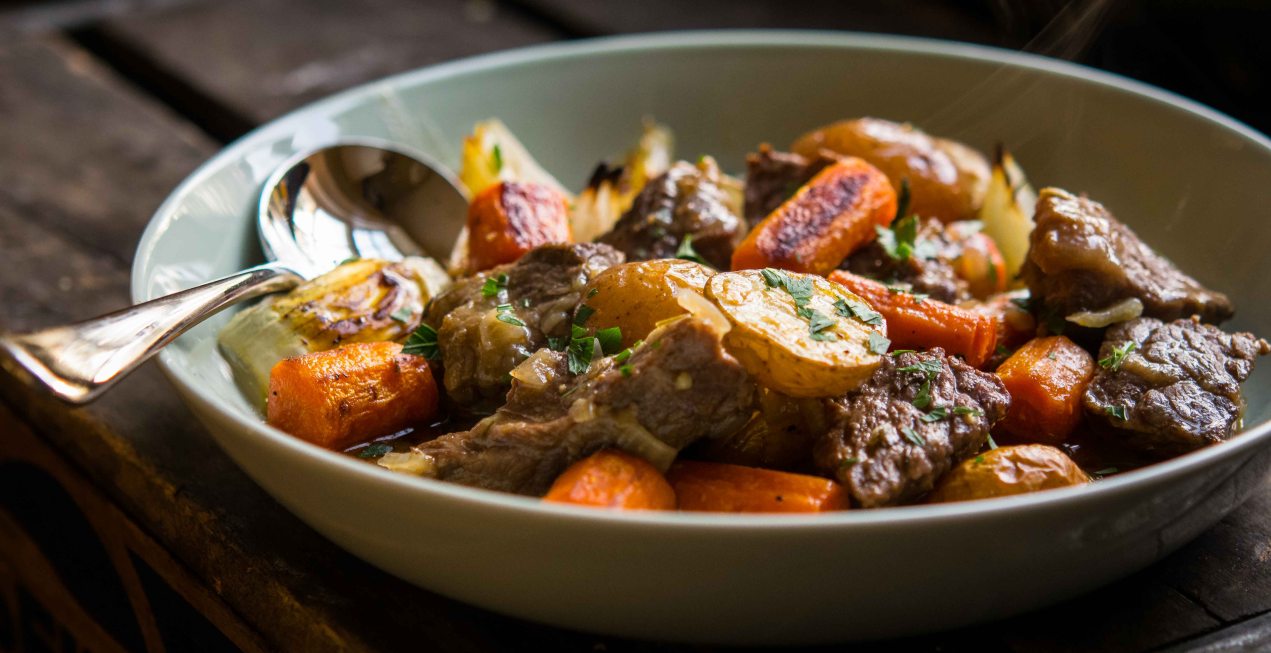If you are like me, you have made what seems like hundreds of variations on beef stew; the classic tomatoey American version, a Korean version, Chinese, Irish, with beer, or with wine. It’s all done in the name of variety and the constant quest for new flavors to excite the taste buds. We do it in order to make dinner ever more interesting, because let’s be honest, if you only cook the same 5 or 6 meals and present them over and over again at some point they become lackluster and boredom sets in. This is not to say, as a cook you need to know how to cook a hundred variations on beef stew because you don’t. If you are like me though you are curious, always looking for upgrades, and it is nice to have some surprises in your back pocket when you need them.
While I call this a French stew it is far from a classic daube. Daube’s make use of lots of red wine, olives, and orange peel. This stew does not. What this dish does do is keep flavors separate. By cooking the meat on its own, roasting the vegetables, then combining them only when it is time to serve the dish some very wonderful flavors only become present when everything is in the bowl.
Let me say a few things about clay pot cooking. Clay is unique, so if you have a clay pot stored in a cabinet somewhere begging to be used then this is a great place to start and here is why. Cooking in clay pots feels like cooking. The smell of the clay as it heats, the aroma that reminds you of the last meal you cooked, the cracks in the glaze, the smell of olive oil as it heats seems basic in an elemental way. It is comforting. It’s as if you a are connected to every cook that came before you and every meal too.
When you heat clay on the stove the culinary history of the particular pot makes itself well known very quickly. Often pots are dedicated to certain kinds of cooking like curry, or rice, or beans. They are used for meals made with similar spices. They are the original slow cooker and you can find them being used all around the Mediterranean, the Middle East, Asia and throughout South America.
The recipe doesn’t require cooking in a clay pot for it to be good but it does add to its mystic. It can be cooked in a slow cooker or in an enameled Dutch oven on the stove top.
Clay Pot Beef Stew with Roasted Vegetables (serves 4)
2 TBS. olive oil
2 pounds beef brisket, trimmed of fat and cut into 1 1/2-inch cubes
1 1/2 TBS all-purpose flour
3 medium yellow onions
15 cloves garlic, peeled and left whole
3 cups homemade beef broth of sodium free beef broth
1 1/2 teaspoons Herbes de Provence
1 tsp. kosher salt
2 tsp. Japanese tonkatsu sauce or Heinz 57
1 bay leaf
2 tsp. flat leaf parsley, minced
3 large carrots, peeled and cut into 1 1/2-inch cylinders
7 fingerling potatoes, washed and halved
- Peel and trim one onion. Halve it and dice both halves into a small dice.
- Place a 3 1/2 quart clay pot or enameled Dutch oven over medium heat. Add olive oil and let it become hot. Add half the beef and brown it on all sides. Remove the meat to a tray. Repeat with the remaining beef.
- Add the flour to the oil and stir with a wooden spoon until the flour begins to color and smells nutty (do not taste the roux it will burn your tongue off.)
- Add diced onions and garlic. Stir. The roux will stick to the vegetables and clump. This is as it should be. Add the hot broth while stirring. Continue to stir until the liquid comes to a boil.
- Add a 1/2 tsp. kosher salt, Herbes de Provence, tonkatsu, bay leaf, parsley, and a few grinds of fresh ground black pepper. Add the brisket back to the pot, bring to a boil, reduce to a simmer, cover and let it gently bubble until the brisket is tender but not falling apart. About 4 hours.
- About 1 1/2 hours before the brisket is tender heat the oven to 425 degrees. Peel the remaining 2 onions and cut each into 6 wedges. Place the onions, carrots, and potatoes into a bowl. Toss with enough olive oil to coat them. Season them with salt and fresh ground pepper. Toss them again.
- Spread the vegetables out onto a sheet tray and roast them for 1 hour or until they are brown and blistered. Remove them from the oven.
- To serve place a sprinkling of vegetables into the bottom 4 bowls, ladle over meat and broth over the vegetables and them top with some vegetables. Sprinkle with parsley and serve.






 Recipe adapted from The French Laundry Cookbook
Recipe adapted from The French Laundry Cookbook